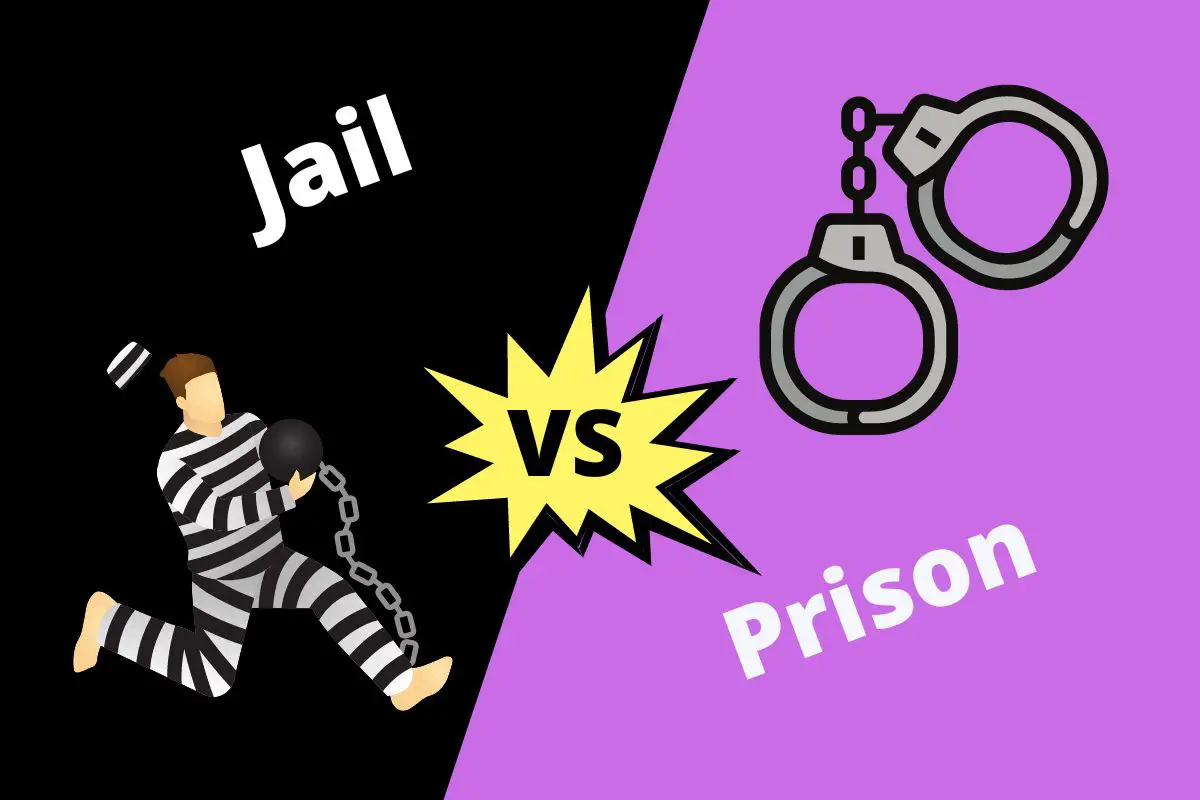The main difference between a jail and a prison is that jail lodges an accused/convict for a short term, whereas the accused/convict is lodged long-term in prison.
When a person does something wrong or commits a crime, they can be arrested and detained by the police to keep them away from society. For the detention, the person may go to jail and eventually prison, depending upon the severity of the crime.
In some countries, both are entirely different facilities. In others, the words jail and prison are used synonymously. Let’s explore the differences between these terms.
Table of Contents
What is a Jail?
Jail is a Middle English word derived from the Latin word cavea, meaning “cage.” Jail is the place for imprisoning someone who has committed a minor offense or someone who is waiting for their trial in court.
The term jail refers to the short period of confinement, which is fitting since the facility is usually small.
Jails are present in the local police station to detain someone for the crime until the final judgment comes. Local law enforcement agencies administer a jail.
It houses people such as pretrial detainees, inmates sentenced by the local government, arrested probation violators, defendants convicted of misdemeanors, etc.
Crimes That Lead to a Jail
Jail is for short-term detention and minor offenses. Here are some examples of crimes that lead to jail.
- Driving under the influence (DUI) of alcohol
- Drug charges
- Assault and battery
- Parole violation

What is a Prison?
The term prison is derived from Old English prisoun, which means captivity or dungeon. A prison is where an individual who has committed any severe offense is incarcerated for a more extended period.
Prisons usually have better facilities for criminals. The state government or the Federal Bureau of Prisons operates prisons.
The main objective of prison is to carry out the rehabilitation and reformation of criminals. A person goes to prison after getting a sentence as a punishment for the crime committed. There are six types of prisons in the USA.

Crimes That Lead to Prison
Prison is for longer sentences for major crimes. Those major crimes are:
- Murder or manslaughter
- Grand larceny
- Sexual assault
- Burglary
Jail Vs. Prison – Some Key Differences
| Jail | vs | Prison |
| Located in the local police station of cities or counties | Area | Several within different states, but function outside of the city or county |
| Small capacity, usually a few holding cells | Capacity | Some prisions have more than 20,000 people |
| Less serious crimes | Severity Of Crime | More heinous crimes |
| To arrest and hold the people who are waiting for trial and sentence | Purpose | To carry out the rehabilitation and reformation of the criminals |
| Local law enforcement agencies | Jurisdiction | State government or Federal Bureau Of Prisons |
| Brief – a day, to a few days, but less than one year | Length of Stay | Longer – usually several months or years |
Jail and prison are often used synonymously but are different from each other.
What’s the Difference Between Jail and Prison?
Location
Jail is often located in the local police stations in the counties (called a county jail). On the other hand, prisons are operated outside of the county. A person could serve in state prison, such as the Indiana State Prison. Also, a person could serve in a federal prison outside of their home state.
Capacity
The jail cells are small and accommodate a few people. However, prisons are larger and can accommodate up to 20,000 or more people in some cases.
Severity of Crime
Jail is for those individuals who have committed less severe crimes or are awaiting trial. In contrast, individuals who have committed more severe crimes are sent to prison to complete their sentences.
Purpose
The primary purpose of the prison is to carry out the rehabilitation and reformation of the criminals. In contrast, the goal of Jail is to arrest and hold the people waiting for trial and sentence.
Jurisdiction
Local law enforcement agencies often control jail. The Federal government or the Federal Bureau Of Prisons oversees prisons.
The Federal Bureau of Prisons of the US manages prisoners through community-based facilities that help offenders with services and programs to become proactive law-abiding citizens.
Length of Stay
The length of stay in jail is for one year or less, while the length of imprisonment can be one year or more.
Maintaining Law and Order in Society
Both jail and prison play an essential role in maintaining law and order in society. However, jail refers to a short-term multi-use incarceration facility. Prison refers to a public correctional facility where prisoners convicted of serious offenses are sent.
Halfway Houses
Apart from this, they differ in the incarceration length, the crime’s seriousness, and the authority that runs them. After serving a prison sentence, an individual might enter a halfway house.
A halfway house is an academy for individuals with criminal backgrounds or drug abuse tendencies. Halfway houses aim to teach the necessary skills to reintegrate criminals into society and better support and care for themselves.
Detention Center vs. Correctional Facility
Sometimes, due to age or other circumstances, an individual might get sentenced to a detention center.
A detention center is designed for individuals who are either arrested, going through processing, or awaiting trial. Detention centers are also for young offenders. On the other hand, a correctional facility is one where convicted offenders serve their sentences.

